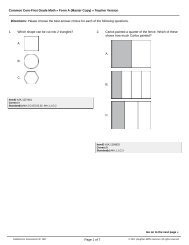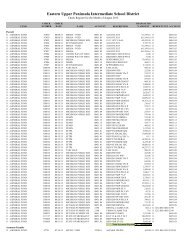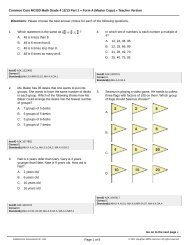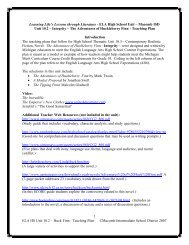Teaching Algebra with Manipulatives
Teaching Algebra with Manipulatives
Teaching Algebra with Manipulatives
You also want an ePaper? Increase the reach of your titles
YUMPU automatically turns print PDFs into web optimized ePapers that Google loves.
Chapter 9 <strong>Teaching</strong> Notes and Overview<br />
3. factors of the product of the area<br />
4. (2x y) by (x y); (x 2y) by (x y)<br />
5. The dimensions of the rectangle represent<br />
the two factors of the trinomial, which is the<br />
area of the rectangle.<br />
Using Overhead<br />
<strong>Manipulatives</strong><br />
Factoring Differences of Squares<br />
(pp. 165–166 of this booklet)<br />
Use With Lesson 9-5.<br />
Objective Model and factor differences of<br />
squares using algebra tiles.<br />
Answers<br />
Answers appear on the teacher demonstration<br />
instructions on pages 165–166.<br />
<strong>Algebra</strong> Activity<br />
Recording Sheet<br />
Difference of Squares<br />
(p. 167 of this booklet)<br />
Use With the activity on page 501 in Lesson<br />
9-5 of the Student Edition.<br />
Objective Model and illustrate the difference<br />
of squares by constructing a rectangle from two<br />
congruent parts of a square and finding its<br />
area.<br />
Materials<br />
algebra tiles*<br />
transparency pens*<br />
straightedge<br />
blank transparencies<br />
colored acetate, if available<br />
* available in Overhead Manipulative Resources<br />
This demonstration consists of an activity and<br />
an extension.<br />
• The demonstration features using one large<br />
square and a smaller square to illustrate<br />
factoring the differences of squares. The area<br />
of the large square is a 2 and the smaller is b 2 .<br />
Students are asked to place the small square<br />
in the upper right corner of the large square<br />
and to shade the remaining part of the large<br />
square. Then students find the area of the<br />
shaded part by cutting it into two trapezoids.<br />
Next, the two trapezoids are rearranged to<br />
form a rectangle. The length is a b and the<br />
width is a b. The area is a 2 b 2 .<br />
Thus, a 2 b 2 (a b)(a b). Then students<br />
are asked to generalize about factoring<br />
differences of squares.<br />
• The Extension deals <strong>with</strong> using algebra tiles<br />
to find the differences of squares. Students<br />
are lead to see that to make a square <strong>with</strong><br />
the tiles, a zero pair of xy tiles are needed to<br />
complete the square. Once again, students are<br />
reminded that adding a zero pair of tiles does<br />
not change the value.<br />
Materials<br />
straightedge<br />
scissors<br />
This activity deals <strong>with</strong> using the area of<br />
squares and rectangles to model the difference<br />
of squares. Students will draw one square<br />
inside and similar to another square. The<br />
smaller square is removed, and the remaining<br />
portion is cut into two congruent pieces. These<br />
pieces then fit together to make a rectangle.<br />
Answers<br />
See Teacher Wraparound Edition p. 501.<br />
Using Overhead<br />
<strong>Manipulatives</strong><br />
Factoring Perfect Square Trinomials<br />
(pp. 168–169 of this booklet)<br />
Use With Lesson 9-6.<br />
Objective Model and factor perfect square<br />
trinomials using algebra tiles.<br />
Materials<br />
algebra tiles*<br />
polynomial models transparency*<br />
transparency pen*<br />
blank transparencies<br />
* available in Overhead Manipulative Resources<br />
This demonstration deals <strong>with</strong> two activities<br />
and an extension.<br />
© Glencoe/McGraw-Hill 154 <strong>Teaching</strong> <strong>Algebra</strong> <strong>with</strong> <strong>Manipulatives</strong>







